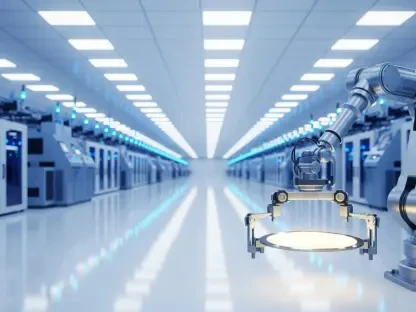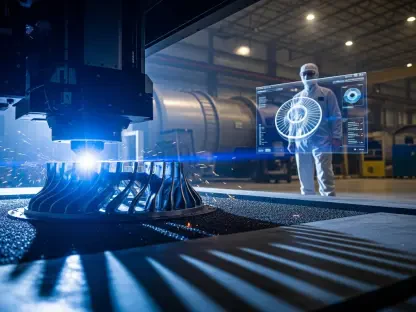Aerospace innovation plays a pivotal role in shaping the modern defense market, fostering growth through technological advancements and strategic collaborations. The aerospace and defense parts manufacturing sector is currently witnessing significant expansion, with projected growth from USD 117.17 billion in 2025 to a remarkable USD 150 billion by 2032. This boom is driven by the increasing demand for advanced military and commercial aircraft components and the rapid technological evolution redefining manufacturing processes. The market’s robust growth underscores the importance of innovation in the aerospace sector, validating its critical role in propelling the defense industry forward. As nations emphasize strengthening defense capabilities, innovations such as additive manufacturing, AI-driven production systems, and the use of lightweight materials have become central to maintaining competitive edges. The pandemic-spurred rebound in commercial aviation further contributes to this positive trajectory, highlighting the sector’s resilience and potential for sustainable expansion.
Market Dynamics and Projections
The aerospace and defense components market is expected to experience a steady growth trajectory with a compound annual growth rate (CAGR) of approximately 2.78% from 2025 to 2032. This projected growth signals an ongoing increase in both the demand and production of military and commercial aircraft. The surge in global defense budgets continues to be a significant factor driving this expansion, with various countries ramping up investments to enhance national security. Simultaneously, the commercial aviation industry shows encouraging signs of recovery from the setbacks experienced during the pandemic, further fueling the demand for advanced aerospace components. Breakthroughs in technology play a pivotal role in this growth by streamlining manufacturing processes, reducing costs, and enabling the creation of more sophisticated, efficient aircraft. As the market expands, it attracts increasing investments and interest, consequently fostering an environment ripe for innovation and advancement in the aerospace and defense sectors.
Emerging markets, particularly in Asia-Pacific, are set to contribute substantially to the growth of the aerospace and defense parts sector. Countries like China, India, and South Korea are significantly boosting their defense spending and focusing on developing indigenous aircraft and defense technologies. These developments are supported by comprehensive improvements in manufacturing infrastructures and government initiatives dedicated to reinforcing aerospace capabilities. Additionally, the integration of cutting-edge technologies enables firms to respond agilely to shifting demands, leveraging innovations such as digital twin technology and AI to bolster production capacity and precision. Such investments facilitate smoother operations and spur the industry’s growth. Consequently, the global competition within the aerospace and defense manufacturing landscape intensifies, driving further technological innovation and market expansion.
Technological Advancements and Innovations
Recent technological developments have been instrumental in revolutionizing the aerospace industry, with additive manufacturing, digital twins, and AI-enhanced production processes at the forefront. Additive manufacturing, commonly known as 3D printing, has particularly transformed production by allowing for more intricate designs, reducing waste, and shortening the time to market for complex components. This technology enhances the precision and customization of parts, making it invaluable for both military and commercial aircraft. Additionally, the integration of AI into manufacturing operations streamlines processes and facilitates predictive maintenance, improving efficiency and reducing operational costs. Digital twin technology, which simulates physical assets in a digital realm, aids in preemptive troubleshooting and optimization of aircraft systems, enhancing reliability and performance.
In the quest for improved fuel efficiency and sustainability, manufacturers are increasingly focusing on advanced materials like composites and titanium alloys. These materials are lightweight yet durable, essential characteristics for modern aircraft striving to meet stricter environmental regulations. Their implementation contributes to reduced emissions and improved efficiency, reflecting the industry’s commitment to sustainable practices. The continued exploration and adoption of innovative materials and manufacturing techniques signal a dynamic shift aimed at overcoming environmental challenges. As companies navigate these advancements, they align their practices with global environmental mandates, positioning themselves at the forefront of sustainable aerospace innovation.
Strategic Collaborations and Industry Landscape
In the fiercely competitive aerospace and defense market, strategic collaborations, mergers, and acquisitions have become critical tactics for companies seeking to expand their capabilities and strengthen their global presence. Industry giants such as Boeing, Airbus, Lockheed Martin, and Raytheon Technologies continue to invest heavily in research and development, striving to produce cutting-edge, reliable aerospace components. Through strategic alliances, they can pool resources, share knowledge, and advance their technological prowess, all while effectively increasing their market influence. Such collaborations not only enhance operational efficiencies but also open new opportunities for innovation, allowing companies to respond effectively to the evolving needs of the aerospace and defense sectors.
The competitive landscape also sees a continuous influx of specialized suppliers, bringing unique capabilities into the market. By focusing on niche areas within aerospace technology, these suppliers diversify the available options and contribute to a multifaceted defense ecosystem. This variety allows larger corporations to leverage specialized expertise while ensuring a robust supply chain. Moreover, such collaboration is essential in aligning with global defense goals, as companies work in unison to address complex national security challenges. Raytheon Technologies, for instance, demonstrates a keen focus on synergy through its integrated defense and aerospace divisions, showcasing how strategic collaboration can create a cohesive and dominant industry presence.
Challenges and Future Outlook
Aerospace innovation is crucial in shaping the defense market today, spurring growth through technological advancements and strategic partnerships. The aerospace and defense parts manufacturing sector is experiencing substantial growth, with projections indicating an increase from USD 117.17 billion in 2025 to an impressive USD 150 billion by 2032. This surge is largely driven by the soaring demand for advanced military and commercial aircraft components and the rapid technological advancements that are transforming manufacturing processes. The market’s robust growth highlights the vital role of innovation in the aerospace sector, emphasizing its importance in advancing the defense industry. As nations focus on enhancing their defense capabilities, innovations such as additive manufacturing, AI-driven production systems, and the use of lightweight materials have become pivotal in maintaining a competitive advantage. The pandemic-induced recovery in commercial aviation further supports this positive trend, showcasing the sector’s resilience and potential for long-term growth.









